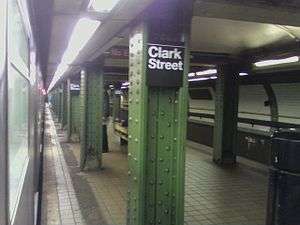Clark Street (IRT Broadway–Seventh Avenue Line)
| Clark Street | |||||||||
|---|---|---|---|---|---|---|---|---|---|
| New York City Subway rapid transit station | |||||||||
 | |||||||||
| Station statistics | |||||||||
| Address |
Clark Street & Henry Street Brooklyn, NY 11201 | ||||||||
| Borough | Brooklyn | ||||||||
| Locale | Brooklyn Heights | ||||||||
| Coordinates | 40°41′51″N 73°59′35″W / 40.6974°N 73.9931°WCoordinates: 40°41′51″N 73°59′35″W / 40.6974°N 73.9931°W | ||||||||
| Division | A (IRT) | ||||||||
| Line | IRT Broadway–Seventh Avenue Line | ||||||||
| Services |
2 3 | ||||||||
| Structure | Underground | ||||||||
| Platforms | 1 island platform | ||||||||
| Tracks | 2 | ||||||||
| Other information | |||||||||
| Opened | April 15, 1919 | ||||||||
| Former/other names | Clark Street–Brooklyn Heights | ||||||||
| Traffic | |||||||||
| Passengers (2015) |
1,997,148[1] | ||||||||
| Rank | 248 out of 422 | ||||||||
| Station succession | |||||||||
| Next north |
Wall Street: 2 | ||||||||
| Next south |
Borough Hall: 2 | ||||||||
| |||||||||
| |||||||||
Clark Street is a station on the IRT Broadway–Seventh Avenue Line of the New York City Subway. Located at Clark Street and Henry Street in Brooklyn Heights, Brooklyn, it is served by the 2 and 3 trains, the latter of which does not stop here during late night hours.
History
On April 15, 1919, the Clark Street Tunnel opened, and this station opened with it, extending West Side Line express trains from Wall Street on the other side of the East River to Atlantic Avenue via a new connection at Borough Hall. The connection doubled the capacity between Manhattan and Brooklyn and eased congestion from the Joralemon Street Tunnel. Direct express service to Times Square was provided to the inhabitants of Brooklyn for the first time as a result.[2]
During the 1964–1965 fiscal year, the platforms at Clark Street, along with those at four other stations on the Broadway–Seventh Avenue Line, were lengthened to 525 feet to accommodate a ten-car train of 51-foot IRT cars.[3]
In 1984–1985, construction was completed to rehabilitate the station. The station was chosen for renovation in 1979, and design work was done in early 1982. Artwork was to be contributed to the design. The platform was refinished, new lights and new signs were installed, and new painting was done. The project was projected to cost $1,250,000 but went over budget. The construction was projected to begin in January 1984, but it quickly fell behind schedule. Issues with the contractors contributed to the delays.[4]
Station layout
| G | Street Level | Exit/Entrance, fare control, station agent (Elevators in station house within Hotel St. George. Note: Platform level is not accessible) |
| M | Mezzanine | Lowest level served by elevators, walkway, stairs down to platform |
| P Platform level |
Northbound | ← ← |
| Island platform, doors will open on the left | ||
| Southbound | → → | |

Clark Street is geographically the westernmost station in Brooklyn on the Broadway–Seventh Avenue Line. It has one island platform and two tracks. Due to the deep-bore tunneling used to construct this part of the line, the station's walls are rounded. On the walls of the platforms are mosaics of sailing ships and large name panels reading Clark Street–Brooklyn Heights.
The platform has two staircases in the center that go up to a passageway, which leads to three elevators. The floor of the passageway contains a 1987 artwork titled Clark Street Passage by Ray Ring and the elevators go up to fare control, which is on the first floor of the now-defunct Hotel St. George. The station is not fully ADA-accessible, since there are no elevators or ramps that lead to the platform. The fare control area contains a small arcade of businesses and two doors that led to the former lobby and checking room of the hotel. The station's two entrances have awnings that read "Hotel St. George."
This is one of three stations accessed by elevators only. The other two—168th Street and 181st Street—are on the same line in Upper Manhattan.
In 1981, the MTA listed the station among the 69 most deteriorated stations in the subway system.[5]
There is supposedly a locked entrance leading directly from the station to the nearby Brooklyn Bridge Park.[6] A 2008 study by Brooklyn Community Board 6 examined the possibility of creating a new entrance to the station from the park; however, it was deemed economically unfeasible.[7]
References
- ↑ "Facts and Figures: Annual Subway Ridership". Metropolitan Transportation Authority. Retrieved 2016-04-19.
- ↑ "OPEN CLARK STREET LINE.; New Route Doubles Subway Service Between the Two Boroughs.". Retrieved 2016-08-26.
- ↑ Annual Report 1964–1965. New York City Transit Authority. 1965.
- ↑ Daley, Suzanne (1985-03-08). "YEAR OF ELAYS PLAGUE RENOVATION OF A BROOKLYN IRT STATION". The New York Times. ISSN 0362-4331. Retrieved 2016-08-28.
- ↑ Gargan, Edward A. (June 11, 1981). "AGENCY LISTS ITS 69 MOST DETERIORATED SUBWAY STATIONS". The New York Times. Retrieved 13 August 2016.
- ↑ Georgia Kral (29 May 2015). "Secrets of Brooklyn Bridge Park". AM New York. Retrieved 7 July 2015.
- ↑ "Brooklyn Bridge Park Transportation+Access Study" (PDF). Brooklyn Community Board 6. 2008. Retrieved 7 July 2015.
Further reading
- Lee Stokey. Subway Ceramics : A History and Iconography. 1994. ISBN 978-0-9635486-1-0
External links
| Wikimedia Commons has media related to Clark Street (IRT Broadway – Seventh Avenue Line). |
- nycsubway.org – Brooklyn IRT: Clark Street
- Station Reporter — 2 Train
- Station Reporter — 3 Train
- The Subway Nut — Clark Street-Brooklyn Heights Pictures
- MTA's Arts For Transit — Clark Street (IRT Broadway – Seventh Avenue Line)
- Clark Street entrance from Google Maps Street View
- Henry Street entrance from Google Maps Street View



